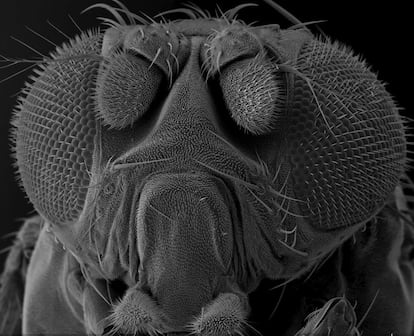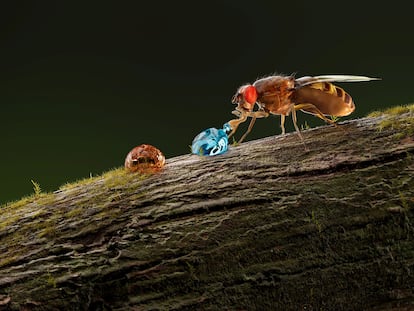Scientists create first genetically modified animal that can have offspring asexually
Researchers from the United Kingdom and the United States transformed the biology of the fruit fly so that it can reproduce without a male in what is known as parthenogenesis or virgin birth

Developmental biologist Alexis Sperling became obsessed with something she saw in the lab when she was studying for her PhD. A praying mantis had young spontaneously, without having sex with a male. A virgin had had children.
This ability has never been observed in mammals, including of course humans, but in the rest of the animal world there are certain species capable of doing it. Many of the cases have been observed in zoos where the females had spent years alone without the possibility of mating.
In 2015, a team discovered one of the first cases of sexless reproduction in the wild: the smalltooth saw fish, which was on the brink of extinction. And just two years ago, at the San Diego Zoo, two females of the endangered California condor gave birth asexually, despite the fact that in this case there were breeding males available.
This phenomenon is called parthenogenesis (virgin birth) and it can be an advantage if the mother is well adapted to her environment and the latter is not very changing. Their offspring, practically clones of the mothers, will not need males to produce offspring. In fact, their reproductive capacity is doubled in this way. It is still an enigma how, when and why parthenogenesis happens and why mammals cannot perform it.
Sperling, an evolutionary biologist at the University of Cambridge (United Kingdom), has cleared up some of these unknowns by creating the first genetically modified animal to be capable of parthenogenesis: the fruit fly, or Drosophila melanogaster. The team achieved this by intervening in three genes. After 40 days without a male to fertilize them—half their lives—the modified drosophilas turned on their new genetic superpowers and produced young all on their own.
An inheritable power
This is the first time anyone has demonstrated how to induce the ability for virgin birth, said Sperling. The offspring is “completely healthy and despite having inherited the power to carry out parthenogenesis, they also retain their ability to reproduce sexually,” adds the biologist, lead author of the study that is published in the specialized journal Current Biology.
Parthenogenesis is one of the least well known biological processes in the animal kingdom. As the eggs mature inside the mother, they divide several times until they are ready, with half of the genetic material needed to create a new individual — the other half provided by the male’s sperm. In this process, a fusion of the ovum with excess genetic material can occur, which gives rise to spontaneous fertilization. The process generates offspring that are very similar to the mother, but not identical, as the original genetic sequence is slightly remixed in the fusion process.
Attempts to get mammals to have young asexually have failed. In these animals, sex-specific epigenetic marks direct the expression of around 150 genes, preventing the development of embryos with only a maternal genome. In other words, certain genes essential for the development of the embryo are deactivated and turned on only when the genetic halves of the female and the male are mixed. In mice, this system has been partially deactivated to generate offspring without the need for males or sex, but it has always required a complex manipulation of the eggs, which then have to be implanted in a female to carry them to term. The biological barriers to parthenogenesis are probably much more complex in primates and humans, so the application of these techniques to assisted reproduction presents many difficulties.
Old-school genetics
Sperling’s team found the key to creating virgin births by studying the genome of two variants of another fly, Drosophila mercator. One reproduces only sexually and the other one only by parthenogenesis. This made it possible to identify two genes responsible for asexual fertilization: the pole —essential for cell proliferation and discovered in the late 1980s by David Glover, co-author of the present study— and Desat2. The scientists found their equivalents in the fruit fly genome and began to cross different lineages until they got one that had the same functioning patterns as the other species. And thus arose the first generation capable of asexual reproduction. If, in addition, the function of the Myc gene, essential for cell growth, is intensified, parthenogenesis becomes much more efficient. “This is old-school genetics,” Sperling acknowledged, but it works.
The discovery has required six years of work and the creation of more than 220,000 flies, something unthinkable with other laboratory animals with longer and much less manageable breeding times, explains Sperling.
Cayetano González, a veteran drosophila researcher at the Barcelona Institute for Research in Biomedicine (IRB), believes that this is a “very surprising” experiment. “Not only have they found the magical combination of genes, but they are also using it to give a species that was not capable of parthenogenesis the ability to do so,” he underscores. The finding shows one of the evolutionary pathways to asexual reproduction in animals, but there are likely many others that have yet to be discovered, he adds.
Sperling is going to redirect his investigation towards a worrying new phenomenon. Parthenogenesis is much more common in insects that are agricultural pests and can cause millions of dollars in losses. An example is the tomato moth —Tuta absoluta—, considered one of the worst agricultural pests globally. Although it was relatively under control thanks to current pest management methods, in recent years the insects seem to have become more resistant.
One method of combating these pests is to flood the greenhouse with artificial female pheromones. The males become so saturated by these biochemical signals that they are unable to find the actual females, resulting in no reproduction. But it seems that female tomato moths are increasingly capable of reproducing by parthenogenesis, and this in turn gives them an enormous advantage, since with each generation it is not only half the individuals adapted to their environment that can have offspring —50% females, 50% males—but potentially 100%. Despite this, experiments have shown that only 2% of second-generation fruit flies produce offspring asexually, and only as long as there are no males around.
Sperling, who used to work in Cambridge’s genetics department, has moved to the university’s associated Crop Research Center. “I want to start to understand how this happens in pests,” he says. “I would like to test all the pesticides we use and see if any of them are promoting parthenogenesis. To know if our means of mass agricultural production really favors this type of pest.”
Sign up for our weekly newsletter to get more English-language news coverage from EL PAÍS USA Edition
Tu suscripción se está usando en otro dispositivo
¿Quieres añadir otro usuario a tu suscripción?
Si continúas leyendo en este dispositivo, no se podrá leer en el otro.
FlechaTu suscripción se está usando en otro dispositivo y solo puedes acceder a EL PAÍS desde un dispositivo a la vez.
Si quieres compartir tu cuenta, cambia tu suscripción a la modalidad Premium, así podrás añadir otro usuario. Cada uno accederá con su propia cuenta de email, lo que os permitirá personalizar vuestra experiencia en EL PAÍS.
¿Tienes una suscripción de empresa? Accede aquí para contratar más cuentas.
En el caso de no saber quién está usando tu cuenta, te recomendamos cambiar tu contraseña aquí.
Si decides continuar compartiendo tu cuenta, este mensaje se mostrará en tu dispositivo y en el de la otra persona que está usando tu cuenta de forma indefinida, afectando a tu experiencia de lectura. Puedes consultar aquí los términos y condiciones de la suscripción digital.











































